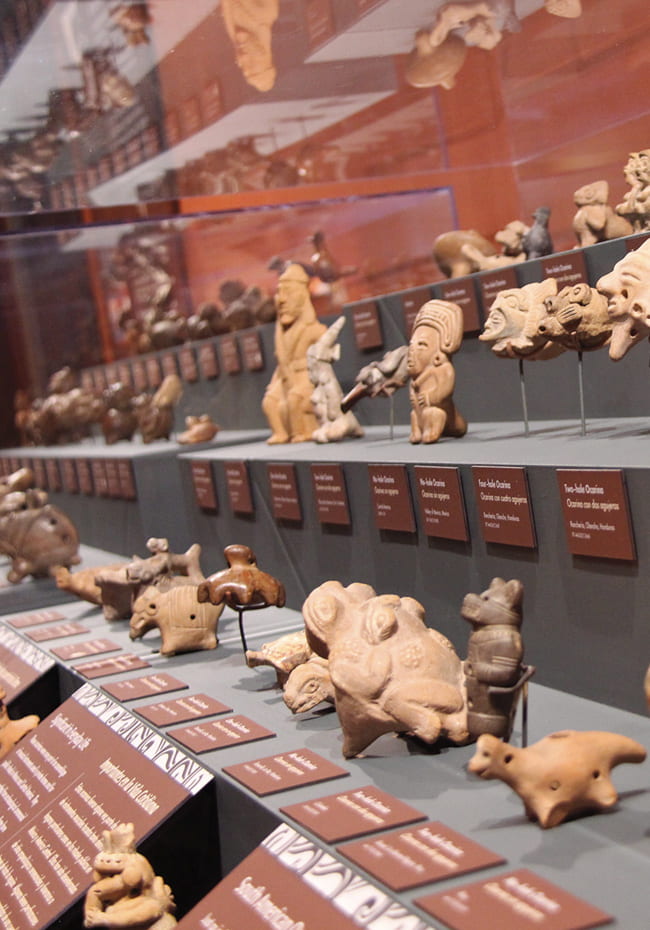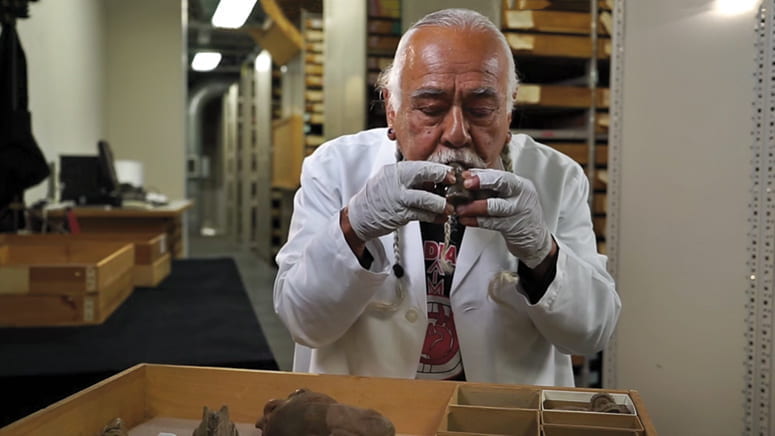
Word & Image
‘They Needed to Be Heard’
Breathing Life into Ancient Ocarinas
Ocarinas of the Americas exhibit at the Peabody Museum of Archaeology and Ethnology at Harvard University. Photo by Kristie Welsh
An ocarina is a type of wind instrument, or aerophone, in which sound is produced by the vibration of air. Unlike flutes, ocarinas are not tubes but consist of one or more enclosed, rounded chambers. They produce sound when air vibrates within the enclosure and exits through a hole near the mouthpiece.
Central America is an ancient home of the ocarina, where it has been crafted and played for more than 4,500 years. Ocarinas were an integral part of the musical traditions of cultures from Mexico through the Andes until European colonization. Fashioned from clay into an array of intricate shapes and complex designs, these ocarinas reflect both expert craft and age-old belief. Today, their form and sounds continue to inspire invention and capture the modern imagination.
“The material world—of earth, of trees, of stone, of clay—is reshaped by the human world,” explains Davíd Carrasco, Neil L. Rudenstine Professor of the Study of Latin America at Harvard Divinity School. “And out of that comes a third thing, which is music and sound and culture.”
“So what we have here are a number of sort of miniatures—small, musical instruments—things made out of the earth,” Carrasco continues. “Music has a sacred power, and in some ways, it is timeless. People can hear ancient music thousands of years old, and yet it will resonate with them today. So it is with this collection of ocarinas.”
The anthropologist and musician José Cuellar (aka “Dr. Loco”), professor emeritus at San Francisco State University, was invited as a Hrdy fellow in 2012 to research and record over two hundred of the Peabody Museum’s ocarinas. “My primary objective was to breathe life into these instruments, to bring them to life,” Cuellar says.

Davíd Carrasco showing the ocarina exhibit to an undergraduate seminar class. Photo by Kristie Welsh
In recent decades, anthropologists have begun to explore the unity of the senses and how it is that the human organism can be understood to have some sort of integrity or integration. One of the things we’re learning is that through ceremonial performances, especially through musical sound, human beings come not only to hear, they come to move, they come to feel, they come to see; they come to feel themselves to be integrated beings.
I think that more research on music, and on the kind of collection we have here, raises a kind of hope for the human community: Can our music be used to integrate, rather than to divide?
—Davíd Carrasco
Mayan Procession

Chiapas, Mexico. pm# 48-63-20/17559. Photo courtesy President and Fellows of Harvard College, Peabody Museum of Archaeology and Ethnology
This is Mesoamerican artist Antonio Tejeda’s reproduction of a section of a wall mural painted 1,300 years ago at the Maya site of Bonampak in southern Mexico. It shows a musician playing a small whistle-like ocarina as part of a procession. The murals of Bonampak provide a window into Mayan life, including how ocarinas, and music generally, contributed to public ceremonies and rituals. Ocarinas are immortalized in both pre-Columbian art and in postcolonial manuscripts. Spanish colonists noted the use of special shrines for musical wind instruments and the playing of ocarina-like whistles and flutes to announce ritual dancing and chanting among the Aztec.
Reconstructing Musical Worlds and Traditions

Four hole ocarina, kneeling male figure, Costa Rica, PM# 52-26-20/18980.2. Photo courtesy President and Fellows of Harvard College, Peabody Museum of Archaeology and Ethnology
By Davíd Carrasco
One of the things that is important to understand about Mesoamerica is that it was not only the place of the primary urban life—the place where the first cities were created—but it also was the place where there was a great collision between European cultures and indigenous cultures. What this did was to destroy an awful lot of indigenous culture.
However, what anthropologists, and especially archaeologists, can do today is to use what I call the “ensemble approach.” To understand the musical world of ancient peoples in Mexico, you have to look, first of all, at pictorial manuscripts that have survived, both pre-Columbian and some colonial manuscripts painted by indigenous people, which portray music, dances, and ceremonies. These actually can show us quite a bit. We combine these with eyewitness accounts. And then you have all of the objects that archaeologists have found. Here you have, in a sense, the most powerful record, because it’s material, it comes out of the ground—and some of them are preserved beautifully.
The fourth kind of resource comes from contemporary ethnographers, people like Professor José Cuellar and others, who are able to go into indigenous communities today, or mestizo communities, where they see and hear—and actually play sometimes—with people who are carrying on some of the ancient traditions. Using all of these resources, we’re on pretty interesting and pretty good grounds when we try to reconstruct some of the ancient musical practices from Mexico and ancient Mesoamerica.

José Cuellar playing an ocarina in Diversity in Form and Song. President and Fellows of Harvard College, Peabody Museum of Archaeology and Ethnology.
I used to think being a musician was about me playing an instrument the way I want to, but after my experience getting to know these ocarinas, I began to relate to instruments according to how they want to be played. Entering the room, I could feel their spiritual energy, and I realized I needed to respect and honor that spiritual aspect. Before I would go to the museum, I would smudge myself with white sage at home. I brought offerings of three different kinds of fine tobacco. In these and other ways I tried to convey to them: “I’m here with good intentions, to understand and to learn.” Since there is no method book on how to play them, I had to develop a relationship with each instrument, to ask it: “Teach me how to play you. Guide me.”
I felt a calling by them to be played. My sense was that they needed to be heard. They wanted their voice out there! For me, in many ways, these instruments express love—love or connection with the spiritual, and love or connection with the social.
—José Cuellar

Animal effigy ocarina, Costa Rica, PM# 976-59-20/24969. Photo courtesy President and Fellows of Harvard College, Peabody Museum of Archaeology and Ethnology
Diversity and Delight
An interview with José Cuellar
I had no idea of the range, variety, and diversity of these instruments until I explored playing them. I slowly discovered the musical potential and limitation of each one: its range, pitch, sound, harmonics. Can it blow OK? How does it feel? I learned that you can’t overblow on some or it hurts them. And no two are alike. If you take two that are the same size and the same number of holes, their pitch and scale will be different. Yet there are very few in-depth studies of whistles, flutes, and ocarinas from Mesoamerican cultures. They’re so prevalent on the ground but so absent in the literature. I think we’re only at the tip of the iceberg in studying and understanding these ancient instruments.

Four hole ocarina, quadruped, PM# 17-3-20/c8064. Photo courtesy President and Fellows of Harvard College, Peabody Museum of Archaeology and Ethnology
The bigger ones, because of their size, and their low pitch, were probably used in home altars or in ceremonies. One of my favorites was this huge dove that had such a rich sound—it sounded like dark chocolate—but its resonance would have been lost outdoors. The smaller ones were probably used in parades and military operations because of the brightness and the power of the sound—they actually sound like whistles, and some are pendants. Many were pleasing to me aesthetically, like one that is an octopus, which has several tubes to it. And they are a delight to play. Because there are no “wrong notes,” you’re always in a space of delight and discovery when you play one. On my saxophone, it’s about improvisation, but on ocarinas, it’s inspiration!

Two hole ocarina, pair of monkeys, Honduras, PM# 47-2-20/17359. Photo courtesy President and Fellows of Harvard College, Peabody Museum of Archaeology and Ethnology
Each object has at least a dual purpose: on the one hand it’s a musical instrument, on the other hand an iconography is present—it is representative of a spiritual entity. Jaguars, turtles, owls, eagles, frogs, and many other animals are represented. There are twins, which is appropriate since everything is at least dual. Many of the ocarinas look one way if you observe one side of them, but if you turn them around, there are different faces on the other side. Some are also meant to be disguises. So they’re often not what they appear to be, and they’re more than one thing. This suggested to me that in this Mesoamerican context, and among Mesoamerican peoples, there was an appreciation for—and an intentional emphasis on—difference and diversity.

No-hole seated human figure with headdress ocarina. Yucatan, Mexico. PM# 53-25-20/19347. Photo courtesy President and Fellows of Harvard College, Peabody Museum of Archaeology and Ethnology
I started thinking about their creation—who were the original molders and makers of these instruments? They had to be multidisciplinarians, because someone needs to know pottery, music, and spiritual iconographic significance to create these. The maker molds the instrument from clay; he or she uses water and earth, then fires it up, and finally blows wind into it. All four elements are needed, so it’s an interesting metaphor for creation. I’ve come to think it was probably a group who made them—either a group of women or a family group. I’ve noticed when I play ocarinas for others that they can have a meditative, calming effect. I played one for a friend who had just had triple bypass surgery, and I’ve started playing them before teaching a class. Might that have been one of their uses? Perhaps families played them after dinner to get into a meditative state and offer their prayers.
Ocarinas of the Americas will remain on view at the Peabody Museum of Archaeology and Ethnology at Harvard University through summer 2018. This bilingual, multisensory exhibit features nearly eighty examples of ocarinas from the museum’s collection. Visitors can hear soundscapes that feature the varied tones and melodies produced by these ancient instruments.
Please follow our Commentary Guidelines when engaging in discussion on this site.

